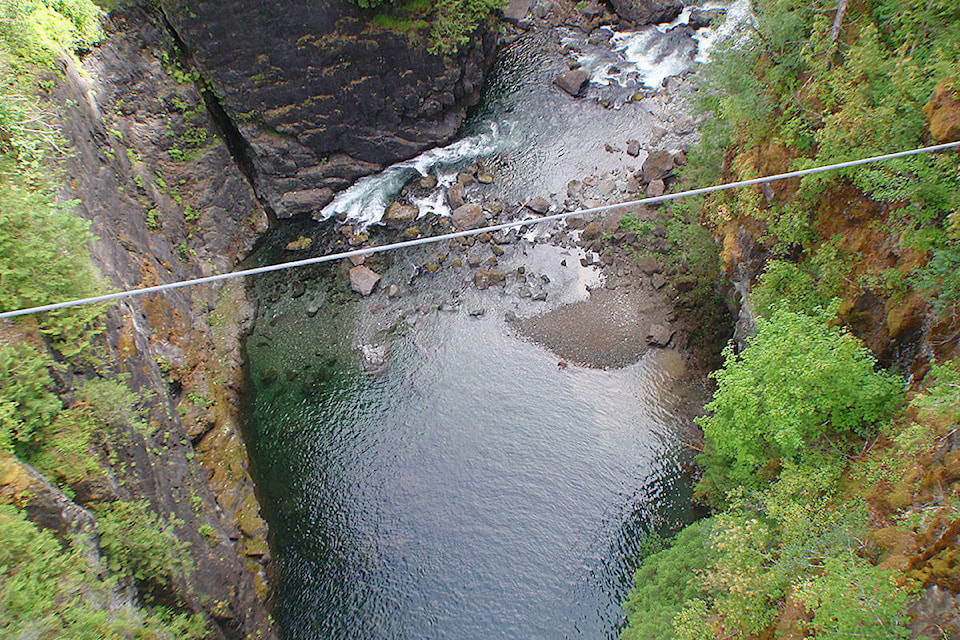BC Hydro is conducting the longest extra water release down Elk Falls Canyon in memory.
From late December until May, the flow rate down the canyon will be up to 15 times higher than the base flow, BC Hydro spokesperson Stephen Watson says.
BC Hydro provides notice of when it has to periodically increase spillage down the Elk Falls Canyon to mitigate inflows in to the Upper Campbell reservoir due to heavy rains or high snowmelt or accommodate maintenance on the generators in the old John Hart Generation Station.
Currently, BC Hydro is conducting the ongoing water release due to losing one generator and in preparation for the switch over to the new, underground generating station currently under construction which will replace the old John Hart Generating Station.
But one good thing out of this is that the higher flows always make Elk Falls more spectacular and a visit to the suspension bridge worthwhile.
“These higher flow rates provide good views of Elk Falls from the safety of the suspension bridge and the lookout,” Watson says. “The public is advised to stay away from Elk Falls, mainly upstream of the falls, for the next five months.”
The fisheries target flow in the Campbell River below the John Hart generating station is 122 cubic metres per second (m3/s) through to the first half of February, and then around 100 m3/s to mid-April, Watson says. Hydro will likely be providing about 110 m3/s, as it has been, through January.
Since October, the existing six-unit generating station has five units operating as BC Hydro begins to switch from the old facility to the new facility currently under construction as part of the approximately $1 billion John Hart Generation Station Replacement Project. And in early February, a second generating unit will be permanently taken off-line.
With five units, Hydro can provide about 100 m3/s of water discharge through the powerhouse, and with four units come early February, about 80 m3/s.
In addition to this, Hydro occasionally needs to take units off-line for planned or unplanned maintenance and repairs. To offset these reductions in available generating unit flow discharges, BC Hydro plans to provide targeted flows below the John Hart facility with increased discharges from the John Hart spillway dam down Elk Falls Canyon. Hydro had to take a generating unit off-line December 22 and it just came back online on Monday. The water release down Elk Falls Canyon had been about 25 m3/s and for the next short while it will back down to the base flow. More unit maintenance is needed next week so canyon flows will go up again to maintain downstream river flows.
“While subject to upstream reservoir levels and overall water abundance, given the pretty good water levels now, we anticipate that flows downstream of the facility will continue to be close to the seasonal targeted fisheries flows,” Watson says.
The Elk Falls Canyon base flow for fish habitat is 4 m3/s, and to meet downstream river flow targets through to early May, the flow rate down the canyon will be up to 60 m3/s, depending on generating unit availability. January canyon flows may by up to about 25 m3/s. Temporary safety signage, advising of the higher canyon flows, will be adjusted as needed through to early May.
This spring, as part of the John Hart Generating Station Replacement Project, the new water bypass facility is scheduled to be operational. This new facility, within the new underground generating station area, can provide up to 80 m3/s of water discharge into the Campbell River from the tunnel outlet located beside the old generating station.
Once available in May, combinations of the bypass facility flows from the tunnel, the existing generating station, and spillway releases as needed down Elk Falls will be used in providing targeted downstream fisheries flows. Later on in the year, as the new generating units come online, they will also provide water discharges through the tunnel until the three-unit powerhouse is fully commissioned in the fall and can provide all of the required seasonal downstream flows.
– This story has been updated with data compiled as of Jan. 9/18
